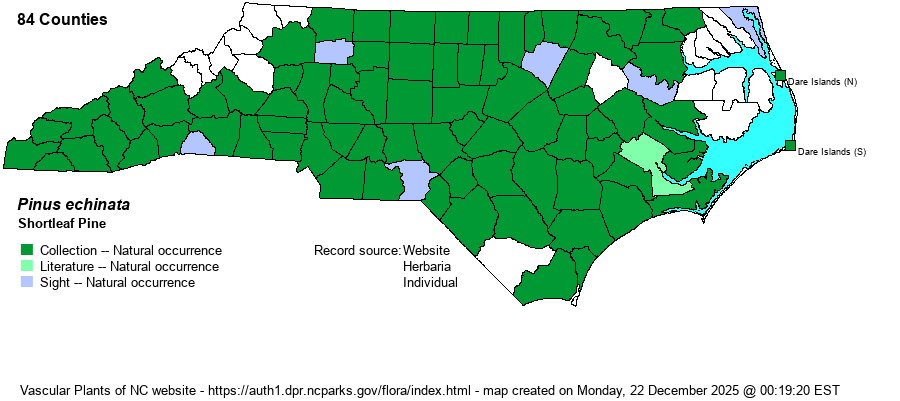| Author | P. Miller | |
| Distribution | The only pine with a nearly statewide range, found throughout the Piedmont, nearly throughout the Coastal Plain (but scarce to locally absent in far eastern counties), and over the central and southern Mountains. It seems to be absent in the northern montane counties, north of Buncombe County. Known locally from Outer Banks maritime forests at Kitty Hawk Woods, Nags Head Woods, and Buxton Woods.
This is a wide-ranging Eastern species, found from NY to MO, and south to northern FL and eastern TX.
| |
| Abundance | Common and widespread in the Piedmont and the upper and central Coastal Plain. However, it is scarce in the eastern third of the Coastal Plain and is mostly absent in the Tidewater zone (around Pamlico and Albemarle sounds) and on coastal islands. It is common in the far southwestern Mountains (below 2000 feet), but becomes uncommon farther northward to the central Mountains. In most of the state, it is outnumbered by other species of pines – Loblolly (P. taeda) in the eastern half of the state, and Virginia (P. virginiana) in the western half, not to mention the locally common Longleaf (P. palustris) and Pond (P. serotina) in the Coastal Plain, and Eastern White (P. strobus) in the Mountains and foothills. | |
| Habitat | It occurs mainly in dry soil, though not in overly rocky or overly sandy conditions. It grows in abandoned fields, on some drier mountain slopes, and in various upland forest types. It can and often does grow in mesic soil conditions, but usually on flats and not on mesic slopes. It normally does not form solid stands anywhere, but it is usually seen mixed with other pines or with hardwoods. |
| Phenology | Pollen is shed in March and April, and the cones mature in September and October. | |
| Identification | This is a familiar, rather large tree, at times reaching 90-100 feet tall, and a trunk of 2-2.5 feet wide. As the common name indicates, the needles are rather short, mainly about 3-3.5 inches long, and usually in fascicles of two, but some in groups of three. The needles are not generally twisted. Virginia Pine has shorter needles, about 1.5 inches long, typically twisted, and almost always in fascicles of two. The mature cones are also smaller than most other pines, being only 2 inches long on average. Several pines in the foothills and mountains are somewhat similar – Pitch (P. rigida) and Table Mountain (P. pungens); see those accounts for identification. | |
| Taxonomic Comments | None
| |
| Other Common Name(s) | Really none, but Yellow Pine is occasionally used, though this name can apply to a group of pine species and is not useful. | |
| State Rank | S5 | |
| Global Rank | G5 | |
| State Status | | |
| US Status | | |
| USACE-agcp | | |
| USACE-emp | | |

